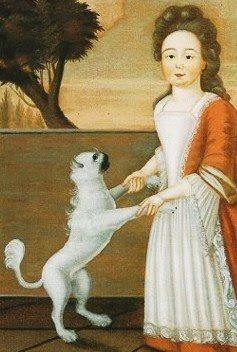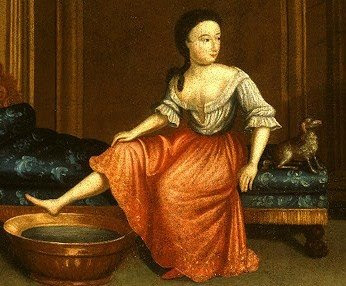 1700 Mrs Augustus Jay. Attributed to Gerrit Duyckinck (1660–ca. 1712).
1700 Mrs Augustus Jay. Attributed to Gerrit Duyckinck (1660–ca. 1712). 1708-10 Artist: Henrietta Johnston 1674-1729. Subject: Mrs. Pierre Bacot (Marianne Fleur Du Gue).
1708-10 Artist: Henrietta Johnston 1674-1729. Subject: Mrs. Pierre Bacot (Marianne Fleur Du Gue). 1708-09 Artist: Henrietta Johnston 1674-1729 Portrait of an Unknown Lady at the South Carolinas
1708-09 Artist: Henrietta Johnston 1674-1729 Portrait of an Unknown Lady at the South Carolinas.jpg) 1708-1709 Artist: Henrietta Johnston 1674-1729. Subject: Mary DuBose Mrs Samuel Wragg
1708-1709 Artist: Henrietta Johnston 1674-1729. Subject: Mary DuBose Mrs Samuel Wragg 1710 Artist: Henrietta Johnston 1674-1729. Subject: Susanne Le Noble, Mrs Alexander de Chastaigner.
1710 Artist: Henrietta Johnston 1674-1729. Subject: Susanne Le Noble, Mrs Alexander de Chastaigner.1700
Population of the British American colonies: about 260,000 people. Boston has 7,000 people and New York, 5000. Jewish population of America numbers between 200 and 300.
Massachusetts representative assembly orders all Roman Catholic priests to vacate the colony within three months, an action also taken by the New York legislature.
Anglicans in England grow concerned that their church does not have a significant presence in North Carolina. The Reverend Daniel Brett becomes the first Anglican minister to serve in the colony. Brett’s disorderly behavior causes him to be called “the Monster of the Age.”
The first public library is established at Bath, North Carolina, with books sent from England by the Reverend Thomas Bray.
Pennsylvania legalizes slavery. (See this blog for more information of enslaved women in the 18th century.)
1701
Yale College in New Haven, Connecticut, is founded.
Charter of Privileges Granted by William Penn, esq. to the Inhabitants of Pennsylvania and Territories, October 28
Charter of Delaware; October 28
1702
Queen Anne, the younger sister of Mary, ascends the English throne. England declares war on France after the death of the King of Spain, Charles II, to stop the union of France and Spain. This War of the Spanish Succession is called Queen Anne's War in the colonies, where the English and American colonists will battle the French and their Native American allies, plus the Spanish for the next eleven years. 1702-1713.
In Maryland, originally founded by Catholic proprietors, the Anglican Church is established as the official church, financially supported by taxation imposed on all free men, male servants, and slaves.
Surrender from the Proprietors of East and West New Jersey, of Their Pretended Right of Government to Her Majesty; April 15
New York passes An Act for Regulating Slaves prohibiting more than 3slaves from meeting together, slaves from testifying in court, and trading by slaves.
1703
Massachusetts requires those masters who liberate slaves to provide a bond of 50 pounds or more in the event that the freedman becomes a public charge.
Connecticut assigns the punishment of whipping to any slaves who disturb the peace or assault whites.
Rhode Island makes it illegal for blacks and Indians to walk at night without passes.
1704
February. Deerfield, Massachusetts is destroyed and 100 residents including women and children are abducted, a consequence of Queen Anne's War.
The Boston News-Letter. Is the first printed version of a formerly handwritten newsletter sent to New England governors by the Boston postmaster is published. It offers local information and foreign news reprinted from English papers. It would continue until 1776 as a mouthpiece for the governor and the Loyalists.
Quakers in the North Carolina assembly are forced to resign after refusing to take a new oath to Queen Anne.
Sarah Kemble Knight (1666-1727) writes her journals which become The Journals of Madam Knight. A record of Knight's trip by horseback from Boston to New York. The author's journal employs dialect and humorously outrageous similes. (See this blog for sections of Madam Knight's Journal)
1705
The Virginia Slave Code codifies slave status, declaring all non-Christian servants entering the colony to be slaves. It defines all slaves as real estate, acquits masters who kill slaves during punishment, forbids slaves and free colored peoples from physically assaulting white persons, and denies slaves the right to bear arms or move abroad without written permission.
In New York, a law against runaway slaves assigns the death penalty for those caught over 40 miles north of Albany.
Massachusetts declares marriage between African Americans and whites illegal.
Charles Griffin, the first schoolteacher in North Carolina, operates a school in Pasquotank County. He later moves to Edenton and runs a school there for several years.
1706
January 17, Benjamin Franklin is born in Boston.
South Carolina declares the Anglican Church its official church.
Connecticut requires that Indians, mulattos, and black servants gain permission from their masters to engage in trade.
1707
Settlers in Charlestown, South Carolina successfully defend their town against an attack by French and Spanish colonists from Havana and St. Augustine
England, Scotland and Wales are combined into the United Kingdom of Great Britain by the Act of the Union, in a plan endorsed by Queen Anne.
1708
“That Properly Belongs to Every Christian Man” This record of Ann Walker's appearance before the governor and Council in Williamsburg documents one part of a continuing dispute between her and George Walker, her husband, over their religious beliefs and practices. (See this blog for more on Ann Walker's plight.)
Surveyor John Lawson, who began a thousand-mile journey through the colony at the end of 1700, publishes A New Voyage to Carolina. It describes the colony’s flora and fauna and its various groups of American Indians. Lawson also publishes a map of Carolina.
New York declares blacks, Indians, and slaves who kill white people to be subject to the death penalty.
Connecticut requires that Indians, mulattos, and black servants gain permission from their masters to engage in trade.
1709
Bathsheba Bowers (1672/3-1718) writes An Alarm Sounded to Prepare the World to Meet the Lord in the Way of His Judgments. (See this blog for more on the life and writings of Bathsheba Bowers.)
The Queen's Acceptance of the Surrender of Government New Jersey; April 17
1710
3,000 German men and women from the Palatinate settle near Livingston Manor on the Hudson River in New York to produce naval stores. When the colony fails, the settlers go first to the Mohawk Valley (in New York) and finally to eastern Pennsylvania.
The English Parliament passes the Post Office Act which sets a postal system for the American colonies controlled by the postmaster general of London and his deputy in New York City.
New York forbids blacks, Indians, and mulattos from walking at night without lighted lanterns. align
See Burt, Daniel S., editor. THE CHRONOLOGY OF AMERICAN LITERATURE: AMERICA'S LITERARY ACHIEVEMENTS FROM THE COLONIAL ERA TO MODERN TIMES. Houghton Mifflin Internet.
Yale Law School, The Avalon Project: Documents in Law, History, and Diplomacy. New Haven, CT.
HISTORY MATTERS. American Social History Project / Center for Media and Learning (Graduate Center, CUNY) and the Center for History and New Media (George Mason University). Internet. http://historymatters.gmu.edu/
+(1601-1673)+Child+and+Sheep,+1655.jpg)
+Lady+Belasyse.jpg)
++Girl+with+a+Lamb+(2).jpg)
+Self+Portrait.jpg)
+Portrait+of+a+Woman+as+St+Agnes+traditionally+identified+as+Catherine+Voss.jpg)
+Portrait+of+Henrietta+Duchess+of+Bolton.jpg)
+De+Peyster+Girl+with+Lamb.jpg)
+Portrait+Of+Franks+Children+with+Lamb+1735.jpg)
+Mary+Sylvester.jpg)
+Elizabeth+and+Mary+Chichester.jpg)
+Girl+with+a+Lamb.jpg)
++Mary+Beekman.jpg)
++Miss+Frances+Warren.jpg)
+Miss+Frances+Warren.jpg)
.jpg)
++Baptist+Noel+4th+Earl+of+Gainsborough+and+His+Wife+Elizabeth+with+their+Children.jpg)

 1710s Justus Engelhardt Kuhn (fl 1707-1717) Young Girl
1710s Justus Engelhardt Kuhn (fl 1707-1717) Young Girl 1715 Attributed to Charles Bridges (1670-1747). Child of Rev. Richard Chase (1692-1742) of London and Maryland, and his wife Margaret Frances Townley (d. 1741)
1715 Attributed to Charles Bridges (1670-1747). Child of Rev. Richard Chase (1692-1742) of London and Maryland, and his wife Margaret Frances Townley (d. 1741)
 1730s Child of the Pierpont Family.
1730s Child of the Pierpont Family. c. 1735 Charles Bridges (1670-1747). Anne Byrd.
c. 1735 Charles Bridges (1670-1747). Anne Byrd. 1720s-30s Gerardus Duyckinck (1695-1746). Jacomina Winkler
1720s-30s Gerardus Duyckinck (1695-1746). Jacomina Winkler 1755 John Singleton Copley (1738-1815). The Gore Children.
1755 John Singleton Copley (1738-1815). The Gore Children. 1758 John Singleton Copley (1738-1815). Mary MacIntosh Royall and Elizabeth Royall.
1758 John Singleton Copley (1738-1815). Mary MacIntosh Royall and Elizabeth Royall. 1730s Gerardus Duyckinck (1695-1746). Lady Undressing for a Bath.
1730s Gerardus Duyckinck (1695-1746). Lady Undressing for a Bath. 1730 John Simbert (1688-1751). Mrs Nathaniel Cunningham.
1730 John Simbert (1688-1751). Mrs Nathaniel Cunningham.+Magdalen+Charlton+(Mrs.+Thomas+Dongan).+Museum+of+Fine+Arts,+Boston.jpg) C 1750 John Wollaston (1710-1775) Magdalen Charlton (Mrs. Thomas Dongan).
C 1750 John Wollaston (1710-1775) Magdalen Charlton (Mrs. Thomas Dongan)..+Anne+Allen+(Mrs.+John+Penn)..jpg) c 1760 Benjamin West (1738-1820). Anne Allen (later Mrs. John Penn). John Penn (1729-1795) was the last governor of colonial Pennsylvania, serving from 1763-1771 & 1773-1776, & he was a grandson of William Penn. Portrait of the daughter of West's benefactor Chief Justice William Allen may have been painted as West was traveling from Pennsylvania to Italy and then to England.
c 1760 Benjamin West (1738-1820). Anne Allen (later Mrs. John Penn). John Penn (1729-1795) was the last governor of colonial Pennsylvania, serving from 1763-1771 & 1773-1776, & he was a grandson of William Penn. Portrait of the daughter of West's benefactor Chief Justice William Allen may have been painted as West was traveling from Pennsylvania to Italy and then to England. 1760 English artist James McArdell (1728-1965) after Joshua Reynolds Joshua Reynolds (English Rococo Era Painter, 1723-1792).
1760 English artist James McArdell (1728-1965) after Joshua Reynolds Joshua Reynolds (English Rococo Era Painter, 1723-1792). 1763 John Singleton Copley (1738-1815) Mrs Jerathmael Bowers.
1763 John Singleton Copley (1738-1815) Mrs Jerathmael Bowers. 1773 Gilbert Stuart (1755-1828). Christian Stelle Banister & Son John
1773 Gilbert Stuart (1755-1828). Christian Stelle Banister & Son John 1787 Henry Benbridge (1743-1812). Hartley Family.
1787 Henry Benbridge (1743-1812). Hartley Family.+Elizabeth+Davis+Mrs+Hezekiah+Beardsley+1749-1790+Yale+Univ+Art+Gallery1st-gallery-art.com.jpg) 1785-90 Beardsley Limner Possibly Sarah Bushnell Perkins (1771 - 1831). Elizabeth Davis (Mrs Hezekiah Beardsley).
1785-90 Beardsley Limner Possibly Sarah Bushnell Perkins (1771 - 1831). Elizabeth Davis (Mrs Hezekiah Beardsley). 1789 - 1791 Payne Limner. Martha Payne.
1789 - 1791 Payne Limner. Martha Payne.





.jpg)


 1758 John Singleton Copley (1738-1815). Detail Thomas Aston Coffin with two birds.
1758 John Singleton Copley (1738-1815). Detail Thomas Aston Coffin with two birds.

+Phil+Acad+of+Fine+Arts+2.jpg)

.jpg)

















